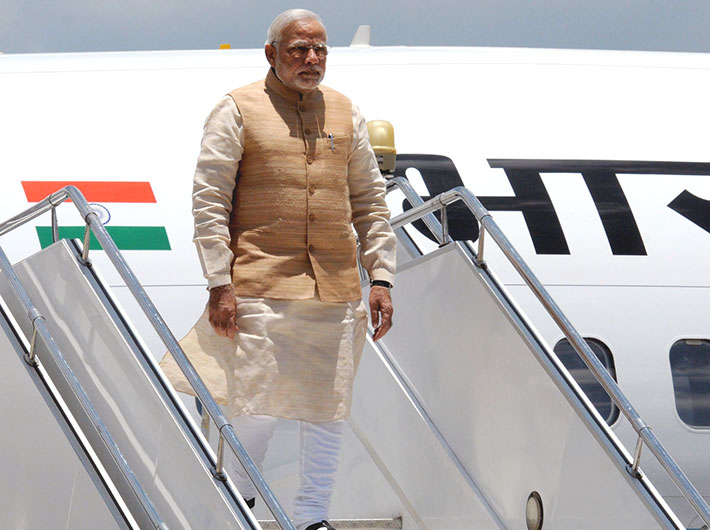How new PM is changing govt's work culture
For such an unprecedented initiative (inviting the Saarc leaders), did he seek out guidance from anybody?
GN Bureau | June 20, 2014

A week before Narendra Modi was sworn in as prime minister on May 26, the first floor of the Gujarat Bhavan turned into a makeshift prime minister's office (PMO). Modi called a retired IAS officer of UP cadre, Nripendra Mishra, and asked him if he could spare some time to help shape his government.
Mishra, who had handled sensitive assignments at the centre and in the state and worked as telecom regulatory authority of India (TRAI) chairman as his last job, readily agreed. Though not known to Modi, Mishra’s name was picked from a list of four officers on the basis of his experience and reputation. Mishra immediately closeted with a set of trusted officers from Gujarat and delineated an unconventional structure of the government which the PM-designate liked. This exercise earned him the job of the principal secretary to the PM, the most powerful bureaucratic assignment in the country.
But what exactly is the new structure that caught Modi’s fancy? Insiders say Mishra, along with two Gujarat cadre officers, AK Sharma and Bharat Lal, chalked out a structure of the PMO which included the posts of a national security adviser, a principal secretary, a secretary (later elevated to additional principal secretary) and a media adviser (perhaps Modi does not require one).
There is nothing innovative in the structure which existed in the past also. The radical departure from the past was the posting of joint secretaries in the PMO on the basis of thematic restructuring of various departments. For instance, the areas of work were clearly marked for six subjects: infrastructure, social sector, home affairs and internal security, economy, accounts and external affairs. In the past, joint secretaries were assigned various departments under their charge in the PMO. This paved the way for redesigning the functions of ministries in consonance with Modi’s maxim “minimum government, maximum governance”.
This exercise was beneficial for portfolio allocation for the cabinet team, which turned out to be small. Though much of the fine-tuning is still on, Modi moved onto another agenda, springing one of the major surprises for the subcontinent. He decided to invite heads of the South Asian Association for Regional Cooperation (Saarc) member-nations for his swearing-in.
For such an unprecedented initiative, did he seek out guidance from anybody, did he consult anybody? There are many versions, but insiders say that Modi consulted none in his party or bureaucracy. He was quite wary of broaching this sensitive subject to diplomats given to traditional understanding of foreign affairs. However, since the function was to be held in the Rashtrapati Bhavan, president Pranab Mukherjee had to be taken on board. Given his vast experience in diplomacy and foreign affairs, Mukherjee’s guidance in the whole affair helped Modi achieve a “coup of sorts”. The South Block bureaucracy was informed only after all the groundwork had been done.
These two instances form a pattern: the new PM trusts his own instincts and entrusts experts the task with specific briefs. If there was any doubt about Modi’s style of functioning, it got cleared when he called for interaction the 77 secretaries of the government of India. Those who attended the meeting returned quite impressed with the PM’s phenomenal memory – as he addressed many of them by name. “It was quite surprising to see him recalling the presentations and suggest effective measures to check various problems,” said one of them. Modi told the secretaries to reach out to him in the event of any confusion, facilitating unbridled access to the bureaucracy for a feedback. Such a situation may raise hackles of traditional archetypal bureaucrats who would doubt its efficacy. But this once again confirms Modi’s penchant for unconventional methods of governance.
Have you ever heard of a PM walking the corridors of his office and visiting departments to wish the staff a “good morning”? Modi has been doing it regularly ever since he started going to South Block. His unexpected visits have prompted bureaucrats to clear their desks, clean up the corridors by removing cupboards stacked with old files and broken furniture. Those monitoring the PM’s moves say that he certainly intends to introduce a work culture where bureaucrats need to prepare themselves for long hours in the office.
As it is, there is buzz in the department of personnel and training (DoPT) that the government is planning to enforce six-day week instead of five days. Though the rumour has been doing the rounds in corridors of the secretariat buildings, government employees seem reconciled to long hours in their office. After nearly a fortnight in office, Modi’s impact is distinctly visible in the functioning of the government.
Though there is an atmosphere of expectation mixed with scepticism, the bureaucracy still seems to work in its old ways. For instance, the files of routine promotion of the IPS officers have got stuck in the home ministry as IAS officers of the same batches are awaiting their promotion.
In a rather curious and surprise move, the home ministry has been working arbitrarily in transferring and postings of police officers ignoring the home minister. A CBI official was denied extension in service despite his organisation’s approval, apparently because he was related to a supreme court judge who passed strictures against the Gujarat government in various cases. Such cases smack of witch-hunting, a charge that will besmirch the new government’s image if not corrected at the earliest.
